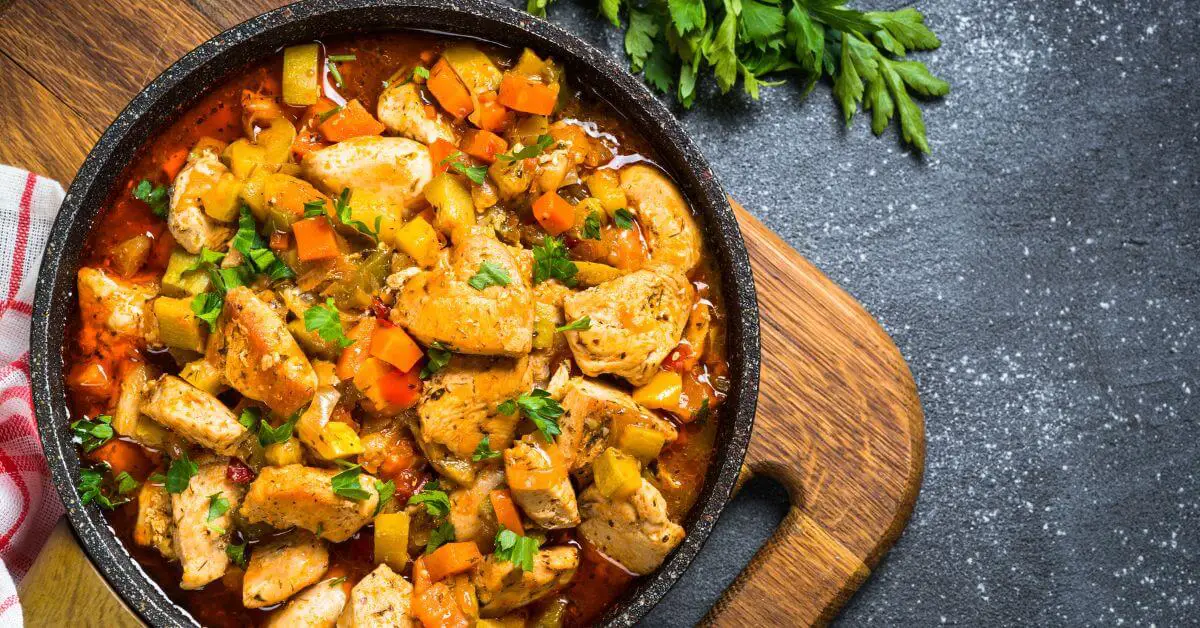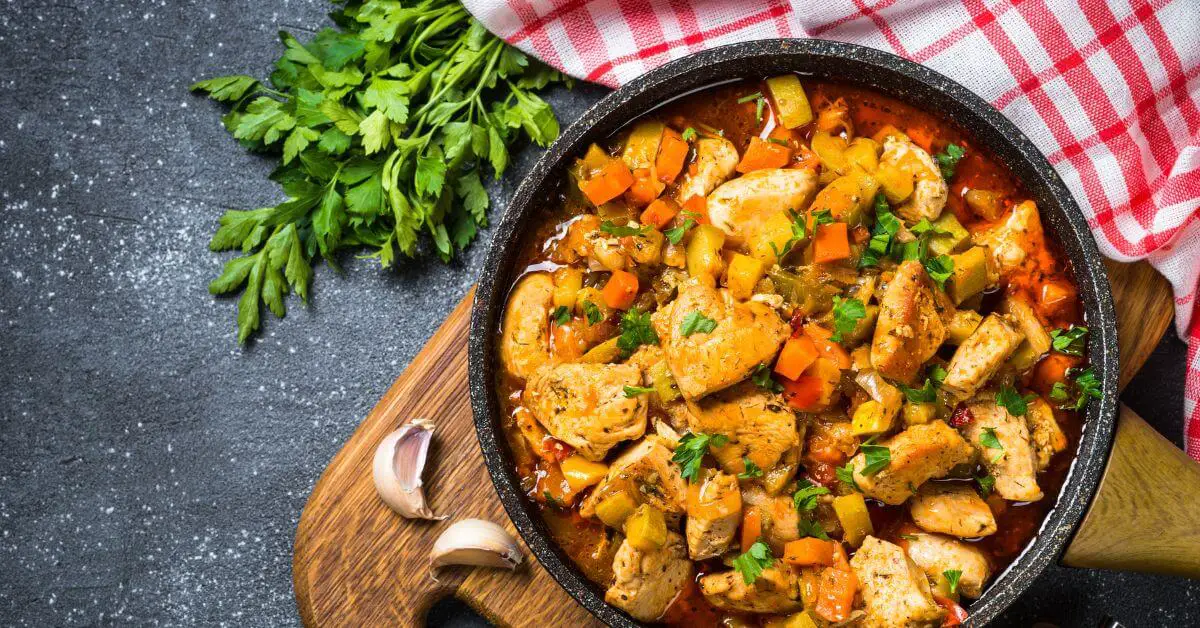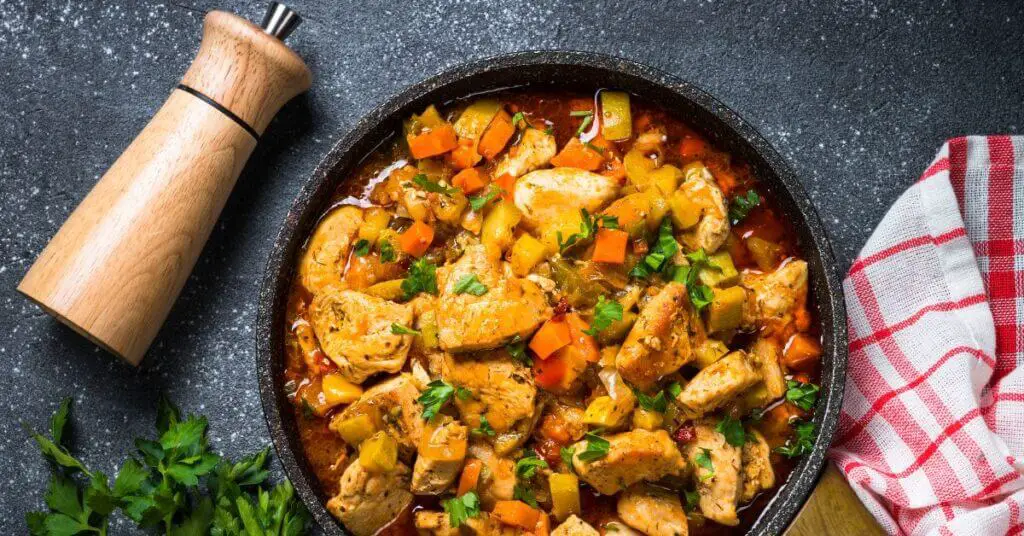Chicken Murphy is more than just a dish; it’s a culinary journey that intertwines the robust flavors of Italian cuisine with the comfort of a home-cooked meal. Originating from the heart of Italy, this dish has carved its niche in the world of gastronomy, offering a delightful blend of tender chicken, spicy Italian sausage, and a medley of vegetables, all simmered to perfection.
In the realm of Italian cuisine, Chicken Murphy stands out for its versatility and rich flavor profile. It’s a testament to the Italian culinary tradition of using simple, fresh ingredients to create dishes that are both nourishing and full of flavor. This dish not only satisfies the palate but also brings warmth and joy to dining tables, embodying the essence of Italian hospitality and family values.
In this comprehensive guide, we will delve into the history and origins of Chicken Murphy, explore its key ingredients, and provide a step-by-step cooking guide to help you recreate this classic dish in your kitchen. We’ll also look at various regional variations, nutritional information, and answer some frequently asked questions. Whether you’re a seasoned chef or a culinary novice, this article promises to equip you with everything you need to know to master the art of making Chicken Murphy.
History and Origin of Chicken Murphy
Origins in Italian Cooking
The story of Chicken Murphy begins in the rustic kitchens of Italy, where the art of combining poultry with robust flavors is a time-honored tradition. Originally, this dish was likely born out of the necessity to create hearty meals from available local ingredients. Italian cooks, renowned for their ability to turn simple ingredients into exquisite meals, would often use chicken, a staple in many households, and pair it with the bold flavors of Italian sausage, fresh vegetables, and herbs. This fusion not only provided sustenance but also offered a comforting and flavorful meal that celebrated the simplicity and richness of Italian culinary culture.
Evolution and Variations
Over time, Chicken Murphy has undergone a fascinating evolution, embracing influences from various Italian regions and beyond. Each region in Italy has its own version, reflecting local tastes and ingredients. For instance, some variations include the addition of artichokes in Tuscany or a spicy kick with Calabrian peppers in Southern Italy. As Italian immigrants settled in different parts of the world, they brought this dish with them, leading to new interpretations. Today, you might find versions of Chicken Murphy with a range of ingredients from mushrooms to bell peppers, each adding a unique twist to the classic recipe.
Popularity in Different Regions
Chicken Murphy’s versatility and rich flavor profile have earned it a beloved spot in both traditional Italian and Italian-American cuisine. In the United States, particularly in areas with a strong Italian influence, this dish has become a staple in many Italian restaurants and households. Its popularity stems from its ability to be both a comforting home-cooked meal and a gourmet dining experience. The dish’s adaptability to different tastes and preferences has also played a significant role in its widespread appeal, making it a favorite across various regions and cultures.
Key Ingredients and Their Roles
Chicken: Types and Preparation
The star of the dish, chicken, plays a pivotal role in Chicken Murphy. Typically, bone-in, skin-on chicken thighs are preferred for their juiciness and flavor. However, variations include using chicken breasts for a leaner option. The preparation of the chicken is crucial – it’s often seared to a golden brown before being simmered with other ingredients. This searing locks in the flavors and adds a depth of taste that is quintessential to the dish.
Italian Sausage: Flavor Contributions
Italian sausage is a key ingredient that infuses Chicken Murphy with its distinctive taste. The choice between sweet and spicy sausage can significantly alter the dish’s flavor profile. Spicy sausage adds a kick and depth, while sweet sausage brings a subtle, herby flavor. The sausage complements the chicken and contributes to the rich, hearty sauce that characterizes the dish.
Peppers and Potatoes: Texture and Taste
Peppers and potatoes add layers of texture and taste to Chicken Murphy. Bell peppers, often a mix of colors, contribute a sweet and slightly tangy flavor, which balances the richness of the meat. Potatoes, on the other hand, absorb the flavors of the sauce and add heartiness, making the dish more fulfilling. Their creamy texture contrasts nicely with the meat and peppers, creating a well-rounded mouthfeel.
Spices and Herbs: Enhancing Flavors
The role of spices and herbs in Chicken Murphy cannot be overstated. Classic Italian herbs like oregano, basil, and rosemary are often used to infuse the dish with aromatic flavors. Garlic and onions are also essential, forming the flavor base of the dish. These ingredients, along with salt and pepper, are carefully balanced to enhance the natural flavors of the chicken and sausage, while also bringing their own unique notes to the dish. The result is a symphony of flavors that is both complex and harmonious.
Step-by-Step Cooking Guide

Preparing the Chicken
- Selection and Preparation: Choose bone-in, skin-on chicken thighs for the best flavor and texture. If you prefer a leaner option, chicken breasts can be used.
- Seasoning: Generously season the chicken with salt, pepper, and a touch of Italian herbs.
- Searing: In a large skillet or Dutch oven, heat olive oil over medium-high heat. Sear the chicken until golden brown on both sides. This step is crucial for locking in flavors and adding depth to the dish.
Cooking the Sausage
- Choosing Sausage: Decide between sweet or spicy Italian sausage based on your flavor preference.
- Preparation: Slice the sausage into bite-sized pieces or, if preferred, keep them in larger chunks.
- Browning: In the same pan used for chicken, cook the sausage until it’s nicely browned. This not only cooks the sausage but also adds a rich flavor to the pan’s fond, which will be used later in the sauce.
Combining Ingredients
- Vegetables: Add chopped onions, garlic, and bell peppers to the pan. Sauté until the vegetables are softened.
- Potatoes: Incorporate diced potatoes, ensuring they are submerged in the cooking liquid for even cooking.
- Chicken and Sausage: Return the chicken and sausage to the pan, nestling them among the vegetables and potatoes.
Seasoning and Final Touches
- Herbs and Spices: Add additional Italian herbs, salt, and pepper. You can also include a pinch of red pepper flakes for extra heat.
- Simmering: Pour in a can of diced tomatoes or tomato sauce, along with chicken broth, and bring the mixture to a simmer. Cover and cook until the chicken and potatoes are fully cooked.
- Adjusting Flavors: Taste and adjust the seasoning as needed. The sauce should be rich and flavorful, with a good balance of herbs and spices.
Presentation Tipsof Chicken Murphy
- Plating: Serve Chicken Murphy in a large serving dish to showcase its hearty and colorful ingredients.
- Garnishing: Sprinkle with freshly chopped parsley or basil for a pop of color and freshness.
- Serving: Accompany the dish with crusty Italian bread or a side salad for a complete meal. Remember, the presentation is key to making the dish as appealing to the eyes as it is to the palate.
Variations
Regional Variations
- Italian Influences: Depending on the region in Italy, Chicken Murphy can see variations like the addition of artichokes in Tuscany or spicy Calabrian peppers in Southern Italy.
- American Twists: In the U.S., particularly in areas with strong Italian-American influences, you might find Chicken Murphy with added mushrooms, different types of peppers.
Dietary Adaptations
- Gluten-Free Version: Use gluten-free sausages and ensure that all other ingredients, like broth or canned tomatoes, are gluten-free. Thicken the sauce with cornstarch instead of flour if needed.
- Vegan Adaptation: Replace chicken and sausage with plant-based alternatives like tofu, tempeh, or vegan sausages. Use vegetable broth and increase the variety of vegetables like eggplant, zucchini, and squash.
For more ideas on adapting chicken recipes to various diets, check out Versatile & Healthy: Adapting Thin Chicken Breast Recipes for Every Diet.
Experimenting with Different Ingredients
- Meat Variations: Apart from chicken, you can experiment with turkey or pork. For a richer flavor, consider using bone-in, skin-on pieces.
- Vegetable Additions: Incorporate vegetables like carrots, celery, or spinach for added nutrition and color.
- Spice It Up: For those who enjoy a bit of heat, adding chili flakes or using spicy sausage can give the dish an extra kick.
- Cheese Topping: Sprinkle some grated Parmesan or mozzarella on top before serving for a cheesy twist.
These variations not only cater to different dietary needs and preferences but also allow for personal creativity in the kitchen, making Chicken Murphy a versatile and universally enjoyable dish.
Pairing with Side Dishes

Recommended Side Dishes
- Crusty Italian Bread: Ideal for soaking up the rich sauce, providing a satisfying textural contrast.
- Garlic Mashed Potatoes: A creamy and flavorful option that complements the hearty nature of Chicken Murphy.
- Roasted Vegetables: Seasonal vegetables like asparagus, bell peppers, or Brussels sprouts, roasted to perfection, can add a healthy and colorful side to the dish.
- Caesar Salad: A classic Caesar salad with crisp romaine, croutons, and a tangy dressing offers a refreshing contrast to the richness of Chicken Murphy.
Complement Chicken Murphy with another savory dish, learn more at French Onion Chicken: Savory Delights for Every Kitchen.
Balancing Flavors
- Acidity: If the dish is heavy, adding a side with a bit of acidity, like a tomato salad or pickled vegetables, can balance the flavors.
- Sweetness: A side dish with a hint of sweetness, such as glazed carrots, can offset the spiciness of the sausage in Chicken Murphy.
- Herbaceous: A side dish with fresh herbs, like a parsley salad, can add a fresh dimension to the meal and enhance the overall flavor profile.
Nutritional Information
Caloric Content
- Chicken Murphy is a hearty dish, and its caloric content can vary based on the ingredients used. On average, a serving can range from 400 to 600 calories. The use of chicken thighs, Italian sausage, and potatoes contributes significantly to the calorie count.
- Modifications for Lower Calories: To reduce calories, one can opt for chicken breasts instead of thighs and use leaner cuts of sausage or even turkey sausage.
Health Benefits
- Protein-Rich: Chicken and sausage provide a good source of protein, essential for muscle building and repair.
- Vitamins and Minerals: Vegetables like peppers and potatoes in the dish are rich in vitamins C and B6, potassium, and fiber, contributing to overall health.
- Balanced Meal: When served with a side of vegetables or salad, Chicken Murphy can be part of a balanced meal, providing carbohydrates, protein, and essential nutrients.
Dietary Considerations
- Gluten Concerns: Traditional Chicken Murphy is typically gluten-free, but it’s important to check the sausage and any added thickening agents for gluten.
- Low-Carb Options: For a low-carb version, reduce the number of potatoes or substitute them with low-carb vegetables like cauliflower.
- Allergies: For those with specific food allergies, ingredients can be adjusted. For instance, dairy-free or nut-free sausages can be used.
- Heart Health: Given the dish’s richness, those with heart health concerns might opt for lower-fat versions of chicken and sausage and increase the proportion of vegetables.
In summary, while Chicken Murphy is a rich and hearty dish, it can be adapted to meet various dietary needs and preferences, making it a versatile option for many.
Common Mistakes and Tips
Avoiding Over/Undercooking
- Chicken: The key is to cook the chicken until it’s just done – overcooking can make it dry, while undercooking poses health risks. Use a meat thermometer to ensure the chicken reaches an internal temperature of 165°F (75°C).
- Sausage: Cook sausage until it’s browned but not charred. It should be cooked through but still juicy.
- Potatoes: Cut them into uniform sizes for even cooking. They should be fork-tender but not falling apart.
Balancing Flavors
- Spices and Herbs: Be cautious with the amount of herbs and spices. Overdoing it can overpower the other flavors. Start with small amounts and adjust as needed.
- Acidity and Sweetness: If the dish is too spicy or rich, add a bit of acidity like lemon juice or vinegar. If it’s too acidic, a pinch of sugar can help balance it out.
- Saltiness: Be mindful of the salt content, especially if the sausages are already salty. Taste as you go and adjust seasoning towards the end of cooking.
Ingredient Substitutions
- Chicken Varieties: If chicken thighs aren’t available, chicken breasts or drumsticks can be used. Adjust cooking times accordingly.
- Sausage Alternatives: If Italian sausage is too strong, milder sausages can be used. For a vegetarian version, consider plant-based sausages.
- Vegetable Swaps: Feel free to swap in or out vegetables based on availability and preference. Mushrooms, zucchini, and carrots are great additions or substitutes.
- Herb Flexibility: If fresh herbs aren’t available, dried herbs can be used in smaller quantities as they are more concentrated in flavor.
By avoiding these common mistakes and following these tips, you can ensure your Chicken Murphy is flavorful, well-cooked, and enjoyable for everyone at the table. Learn more about one-pan Chicken Murphy preparation at La Boite NY.
FAQs
What is Chicken Murphy?
Chicken Murphy is a hearty Italian-American dish combining chicken, Italian sausage, and vegetables in a flavorful sauce. It’s known for its robust taste and comforting qualities.
Can You Make Chicken Murphy Vegetarian?
Yes, you can make Chicken Murphy vegetarian by substituting chicken and sausage with plant-based proteins and increasing the vegetables.
How Should You Store and Reheat Chicken Murphy?
Store Chicken Murphy in an airtight container in the refrigerator for up to 3-4 days. Reheat it on the stove over medium heat, adding a little broth or water if needed.
What Are the Common Allergens in Chicken Murphy?
The common allergens in Chicken Murphy include gluten (in some sausages and broth), dairy (if used), and potentially soy (in some sausage varieties). Always check labels if you have allergies.
Join the discussion on Chicken Murphy preparation at Hungry Onion.
Conclusion
In this article, we’ve explored the delightful world of Chicken Murphy. This Italian-American dish is a fusion of rich flavors and comforting textures. We’ve covered its history, key ingredients, and cooking steps. Variations for different diets and regional twists were also discussed. Pairing suggestions with sides and drinks were provided to enhance your dining experience. Tips to avoid common cooking mistakes were shared for a perfect meal. Finally, we answered frequently asked questions about Chicken Murphy. For another Italian classic, try our Garlic Parmesan Chicken Pasta.
Now, it’s your turn to try this classic recipe. Whether you’re a seasoned cook or a beginner, Chicken Murphy is sure to impress. So, gather your ingredients and start cooking. Enjoy the rich taste of this Italian-American favorite in your own kitchen!
